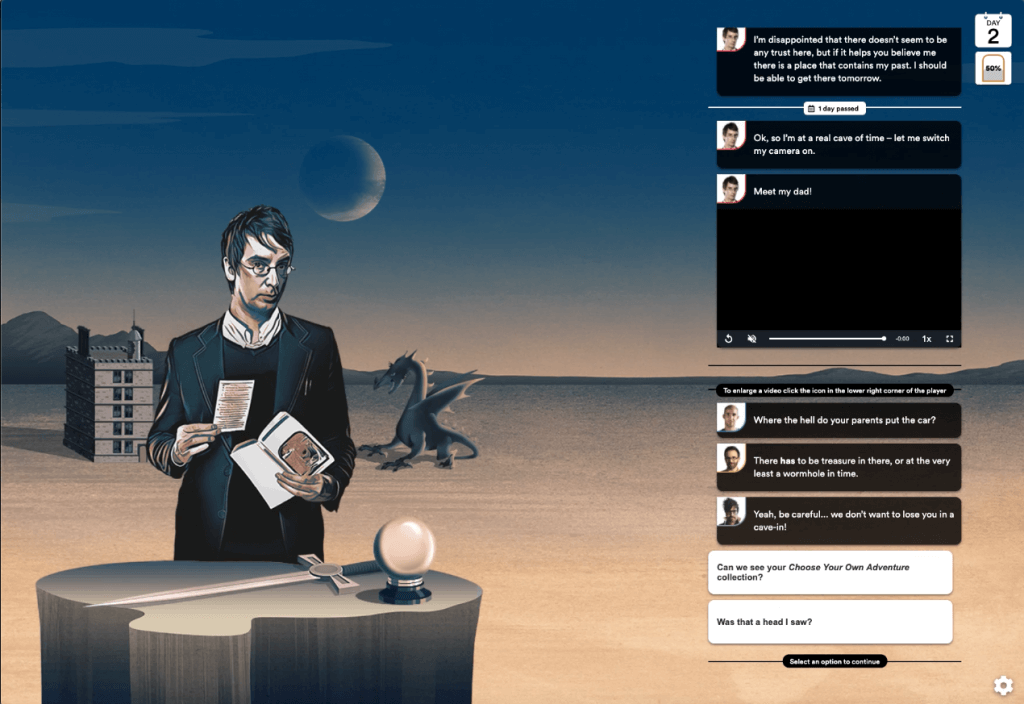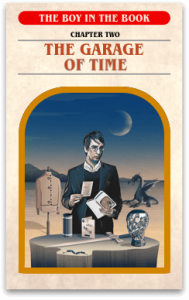Translating documentary storytelling into a captivating digital experience
If you grew up in the 80s or 90s, you’re probably familiar with the idea of Choose Your Own Adventure from the children’s books. Make a choice, turn to a page, find out the consequence. Maybe you caught Netflix’s foray into the genre, Bandersnatch. How about Choose Your Own Documentary?
We built a unique project, translated a live stage-based documentary into an online experience. From the start, this is a project that has given us some big UX challenges. And how we love a challenge.
Introducing The Boy in the Book
The Boy in the Book was a live stage show documenting the real-life story of Nathan (our client), in his search for the boy who had owned a full collection of Choose Your Own Adventure books, which Nathan had bought on eBay. The boy, named Terence, had written in the books; poignant, heartbreaking, angst-ridden scribblings about his own life. He had even overwritten some of the words of the stories to reflect his feelings and in one of the books, some pages of a forgotten diary fell out, which told desperation.

Reading through this boy’s thoughts and stories, Nathan saw parallels with his own life. This spurred him to go on a quest to find Terence, which developed into a story with twists and turns, emotional highs and lows and, for Nathan, a journey of self-discovery as the search for the boy unfolded.
In keeping with the books where it all began, the audience of the live stage show dictates the direction of the narrative, collectively voting on choices that Nathan himself had to make throughout his search.
From stage to screen
This was a truly co-produced project. The Choose Your Own Documentary (CYOD) Team received funding to adapt the show from The Space – whose remit is to capture live performances and extend their audience reach through digital.
Whilst the CYOD team has a strong background in linear media, including TV, stage and books, we were brought on board to develop a digitally-native storytelling concept.
We worked through multiple concepts. In an early iteration, we tried a video-only version using videos of Nathan presenting his story. There were a few reasons why, once the demo was produced, we knew this wasn’t the right way to tell the story.
The user ended up with long chunks of video to watch before any action was required. This lends itself well to a ‘lean back’ experience, like watching a live show or a film but not necessarily the ‘lean in’ game type experience you’d expect from the CYO genre. Whereas Netflix’s Bandersnatch did a good job of merging the CYO concept with a lean-back experience, the advantage of working with a TV interface, operated primarily with a remote control created a very different user experience to that which we were working towards.
Whereas on stage, Nathan was able to interact with his audience, reading their responses and tweaking his delivery to suit, this isn’t possible with video footage, which left us with an even lesser sense of interactivity and user input.
We were also working with two completely different audience dynamics. The group dynamic of a theatre audience gives each member a limited feeling of involvement; they allow themselves to get involved to an extent, but ultimately the wisdom of the crowd decides. Our new digital user is likely to be alone and with this comes a far greater sense of responsibility. The user is responsible for the outcomes they choose. We needed an experience that offered up more agency; more opportunities to shape a unique narrative and to keep the user engaged with the experience.
We had to tell the same story, in a very different way.
From viewer to maker
What if we repositioned the role of the user entirely? What if the user didn’t just follow Nathan’s footsteps, but walked in his footsteps? What if the user was a member of the documentary team tasked with bringing the search for the boy in the book to life?
In this solution you are invited to relive Nathan’s journey, being exposed to the actual process of making a documentary. To deliver a convincing experience that will truly engage the user, we had to build in all the parts of the real-life process. The team members, the decisions, the excitement, the obstacles and the frustrations.
We mapped out the experience, including the user’s emotional state throughout the journey. This enabled us to build an interface that supports and fuels emotions, encouraging feelings of excitement and fulfilment, but also the stress and apprehension that comes with a game-like experience. Arranging the interface was much like putting together a stage; we used elements like lighting, tone and music to underscore emotion.

We also had to consider that an online user is unlikely to complete the experience in one sitting, as audience members at the live show do. This meant structuring the narrative in ‘bitesize’ chunks, that could be dipped in and out of, much like a video game experience.
To create the illusion of being part of a team, we incorporated a chat inspired interface to replicate team conversations. We programmed in familiar and informal phrases to mirror real speech and responses, that were tuned into the emotional states we predicted during the mapping stage. Small throwaway interactions are included throughout the journey which acts as hooks to keep the user feeling close to, and in control of the action.
Making the journey the destination
In making The Boy in the Book, we feel like we’ve been on a ‘choose your own’ adventure, of our own. With the amazing willingness of the CYOD team to let us experiment, evaluate and change direction, and to come on this journey with us, developing new skills of their own, we’ve arrived at a truly co-created product.
Translating an offline interactive experience into digital is, as we’ve learned, about far more than recreating the story in a different format. The storytelling technique has to be completely reconfigured, prioritising the user’s situation and expectations, making their role throughout the entire journey as fulfilling as the ending they arrive at.
Did Nathan ever find the boy in the book? Try it for yourself and see where your documentary takes you.
How can we help you?
We can help you use digital technology to understand and connect with your audiences; to work more efficiently and profitably; and create things you didn’t dream possible.
We work across industries on projects of all sizes. The earlier we’re involved, the more value we can add. We’d love to work with you – we’re always happy to chat.